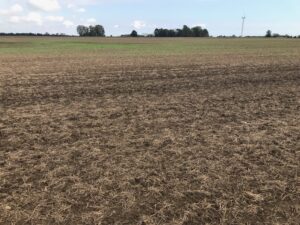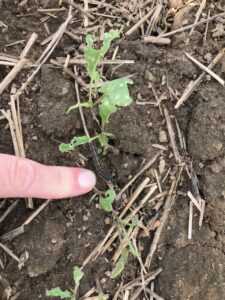Scout vulnerable crops for feeding and larvae including winter canola, winter cereals, forages and cover crops. Especially in the southwestern counties but not limited to this area. Currently, there seems to be a pocket in the Blenheim area that requires attention.
Meghan Moran has found three winter canola fields near Blenheim this week that have been taken out by fall armyworm (FAW) feeding. Based on the size of the larvae, they are third and fourth instar larvae which are starting to be their hungriest stages. These larvae came from a large late August flight of moths. These moths likely laid eggs in any green vegetation they could find in late August, early September. These include fields with weedy patches, very late planted soybean fields, early planted wheat fields, forages and cover crops. Normally by now, temperatures would be much cooler, which would have delayed or halted this late flush of FAW larvae from developing to these later instar stages. The base temperature for FAW development is 13 degrees C, meaning that the mean of both the high and low temperature each day needs to be at least 13 degrees for the larvae to continue to grow. The lack of cooler nights this fall, as well as summer like daily highs has helped them continue.


There are no established thresholds for FAW this late into the fall, especially for fall seeded crops. It is a matter to determining if and how much injury or stand loss is occurring that could impact the crop’s winter survival. The crop, size of the larvae and size of the plants at the time of the feeding, as well as forecasted temperatures will determine if action is needed. FAW do not tend to clip the growing points of cereals and grasses but they do in winter canola and newly seeded forages, if the plants are small enough. Control may be warranted if 25% of the plants have feeding and/or cutting and larvae are still actively feeding. A frost event will kill these larvae. If insecticides are going to be effective, the larvae need to be 2.5 cm or smaller in length. Do not apply insecticides prior to a heavy rain.
Not all of these crops will have products with fall armyworm on the label. Refer to Publication 812, Field Crop Protection Guide and contact your agronomist or OMAFRA specialist for guidance on potential options.
